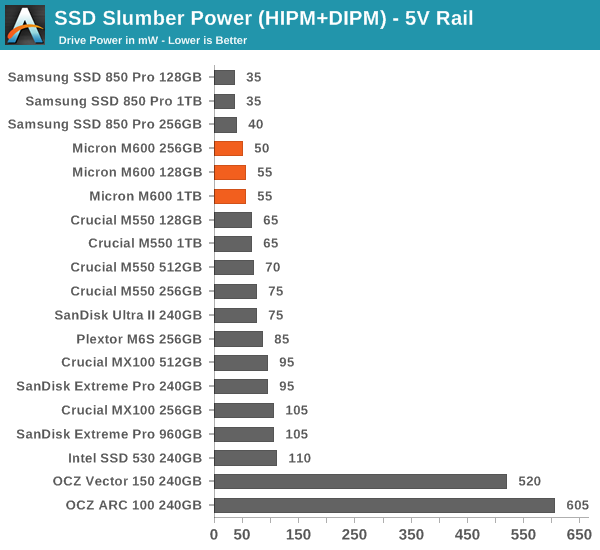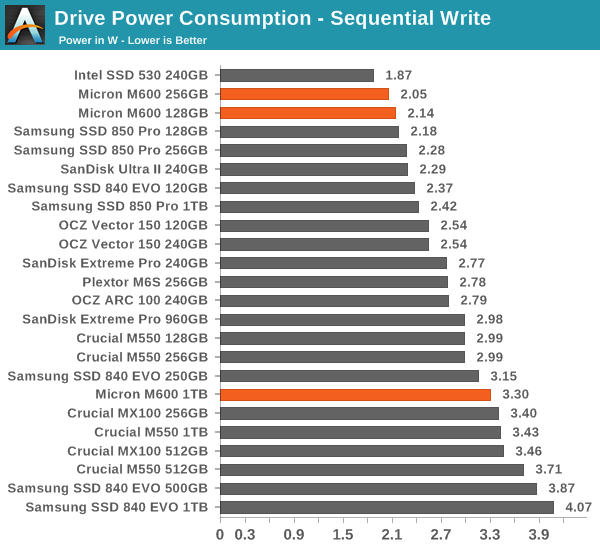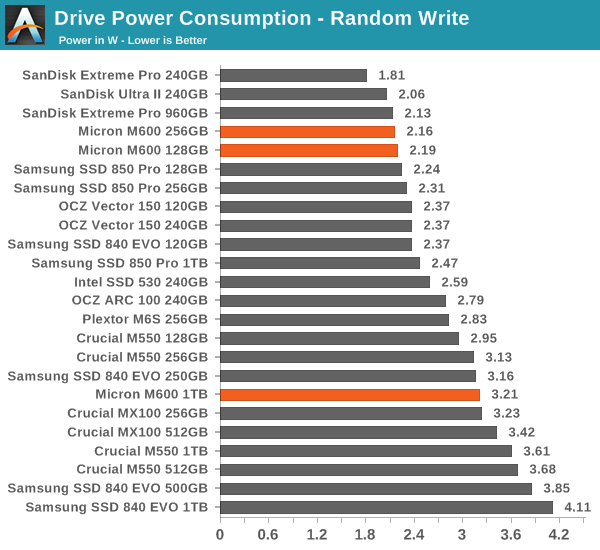Micron M600 (128GB, 256GB & 1TB) SSD Review
by Kristian Vättö on September 29, 2014 8:00 AM ESTPower Consumption
The M600 brings a fairly significant reduction in slumber power consumption compared to the MX100. I believe OEMs are more demanding on power requirements because the majority of SSDs will be shipped in mobile systems. While SSD power consumption only plays a small part in total power consumption, it is still important to save power on every aspect where possible to maximize battery life.

Load power consumption is also good and it seems that the Dynamic Write Acceleration helps a bit here. Writing to pseudo-SLC NAND is more efficient because less iterations and verifications cycles are needed compared to MLC or TLC, which brings the power consumption down during write operations.












56 Comments
View All Comments
Kristian Vättö - Wednesday, October 1, 2014 - link
Oh, that one. It's from the M600's reviewer's guide and the numbers are based on Micron's own research.maofthnun - Wednesday, October 1, 2014 - link
Thanks for the clarification on the powerloss protection feature. I am very disappointed by how it actually works because that was a major deciding factor in my purchase of the MX100. At the time, the choice was between the MX100 and the Seagate 600 Pro which was $30 more and which also offers powerloss protection. I would have gladly paid the extra $30 if I had known the actual workings of the MX100.Since we're on the topic, I wonder if other relatively recent SSDs within the consumer budget that offer powerloss protection (e.g. Intel 730, Seagate 600 Pro) work the way everyone assumes (flush volatile data)? Would love to hear your comment on this.
Kristian Vättö - Wednesday, October 1, 2014 - link
Seagate 600 Pro is basically an enterprise drive (28% over-provisioning etc), so it does have full power-loss protection. It uses tantalum capacitors like other enterprise SSDs.http://www.anandtech.com/show/6935/seagate-600-ssd...
As for the SSD 730, it too has full power-loss protection, which is because of its enterprise background (it's essentially an S3500 with an overclocked controller/NAND and a more client-optimized firmware). The power-loss protection implementation is the same as in the S3500 and S3700.
maofthnun - Wednesday, October 1, 2014 - link
Thank you. I'll be targeting those two as my future purchase.RAMdiskSeeker - Wednesday, October 1, 2014 - link
If the 256GB drive were formatted with a 110GB partition, would it operate in Dynamic Write Acceleration 100% of the time? If so, this would be an interesting way to get an SLC drive.Romberry - Friday, January 9, 2015 - link
I'm really not sure that the AnandTech Storage Bench 2013 does an adequate job of characterzing the performance of this drive or really, any drive in a consumer class environment. And I'm not sure that filling all the LBA's and looking at the psedo-SLC step down as the drive is filled really tells us anything useful (other than where the break points are...and how much use is that?) either.Performance consistency? Same deal. Almost no one uses consumer class drives (large steady long term massive writes) this way, and those who do use drives this way likely aren't using consumer class drives.
I can really take nothing useful away from this review. And BTW, this whole "Crucial doesn't really have power protection, we didn't actually bother checking but just assumed and repeated the marketing speak before" stuff is not the kind of thing I expect from AnandTech. With that kind of care being taken in these articles, I'll be careful to read things here with the same sort of skepticism I had previously reserved for other sites. I'd sort of suspended that skepticism with AnandTech over the years. My mistake.